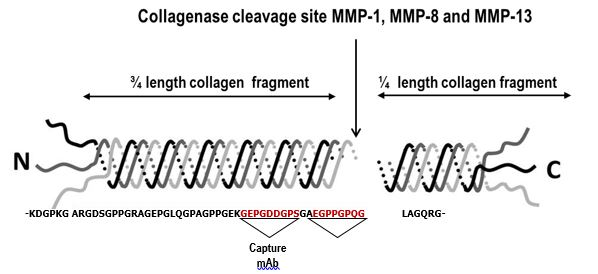IB-C2C-HUSA™ Collagen Type II Cleavage Sandwich Assay
aka: uC2C Cat. # 60-1017

Intended use:
The C2C-HUSA ELISA kit measures cartilage degradation. This assay with specific monoclonal antibodies is primarily designed to detect a type II collagen 45-mer collagenase-generated cleavage fragment commonly found in human urine. In a sandwich assay design the capture mAb is specific for intra-chain sequence and Tracer-HRP mAb is specific for C2C C-terminal neoepitope.
Click here – to download the C2C-HUSA Specification Sheet
Method: ELISA sandwich, 96 wells strip plate
Sample type: Human urine only
Sample volume: 30 µL per replicate
Calibration range: 156 – 5000 pg/mL
Incubation time: 2 hours
Species: Human. Not suitable for equine use. Utility in other species has not been established
Cross-reaction: No cross-reaction with corresponding neoepitope peptides derived from collagen type I and collagen type III is detected
Recently published paper (24th December 2021) MDPI Applied Sciences
Associations of Urinary Collagen II Neoepitope C2C with Total Knee Replacement Outcomes: Is OA a Systemic Disease in Rapidly Progressive Cases?
Liisa Kuhi 1.2 Ann E Tamm 1 Jaanika Kumm 1,3 Kristel Järv 1.3
Aare Märtson 1.4 Agu O. Tamm 1 Kalle Kisand 1
- Institute of Clinical Medicine, Faculty of Medicine, University of Tartu, 50406 Tartu, Estonia
- Central Laboratory, Diagnostic Clinic, East-Tallinn Central Hospital, 10138 Tallinn, Estonia
- Radiology Clinic, Tartu University Hospital, 50406 Tartu, Estonia
- Traumatology and Orthopaedics Clinic, Tartu University Hospital, 50406 Tartu, Estonia
Abstract
The objective of this study was to investigate the dynamics of the urinary collagen type II C-terminal cleavage neoepitope (uC2C) before and after total knee replacement (TKR) in rapid knee OA progressors. C2C in the urine was measured by IBEX-uC2C assay in 86 patients (mean age: 59.9 years) with symptomatic knee OA (kOA) undergoing TKR, assessed before surgery and 3 and 12 months after. The patients’ condition was determined by self-assessment questionnaires, by lower limb performance tests, and by radiography. In the preoperative period, the uC2C level was significantly higher in females than in males, and was associated with the radiographic severity of kOA. A weak correlation between the C2C and knee pain was observed in the whole group and in males, but not in females. The individual dynamics of uC2C after TKR were heterogenic. In general, uC2C increased three months after TKR, but fell to the preoperative level after 12 months. A higher preoperative uC2C implied the tendency to diminish as a result of TKR, and vice versa. TKR did not stop the degradation of Coll2 in the tissues in the majority of cases. The pre-TKR uC2C predicts the postoperative uC2C level. The uC2C dynamic seems to be sex-specific, so it could be considered a prospective pre- and post-TKR biomarker for progressive kOA.
Published paper (10th July 2021) MDPI Applied Sciences
Risk Assessment of the Progression of Early Knee Osteoarthritis by Collagen Neoepitope C2C: A Longitudinal Study of an Estonian Middle-Aged Cohort.
Liisa Kuhi 1.2 Ann E Tamm 1 Agu O. Tamm 1 Kalle Kisand 1
- Department of Internal Medicine, Institute of Clinical Medicine, Faculty of Medicine, University of Tartu, 50406 Tartu, Estonia
- Central Laboratory, Diagnostic Clinic, East-Tallinn Central Hospital, 10138 Tallinn, Estonia
- Sports Medicine and Rehabilitation Clinic, Institute of Clinical Medicine, University of Tartu, 50090 Tartu, Estonia.
Abstract
One of the unmet needs to be addressed is prognostic biomarkers for early knee osteoarthritis (kOA). We aimed to study the association of urinary collagen type-II C-terminal cleavage neoepitope (uC2C) with the emergence and progression of kOA. The longitudinal data of 330 subjects (aged 32-60 years) from an Estonian population-based cohort were used. The radiographic progression was evaluated by the grading system of Nagaosa et al. of knee compartments at baseline and three years later. The emerging kOA consisted of subjects with developing osteophytes or joint space narrowing, whereas kOA progressors showed aggravation of radiographic grade. Baseline uC2C levels were measured by the IBEX-uC2C assay. At baseline, the subjects were middle-aged (mean age, 47.6 years) and overweight (mean BMI, 28.0 kg/m2), and the majority of them (51.2%) had a diagnosis of kOA grade 1. Multiple logistic regression models adjusted for sex, age, and BMI were used for risk calculations. We demonstrate that increased uC2C accurately predicted the risk of emerging of kOA (OR = 5.87 (1.71-20.22); AUC = 0.79) compared with controls without radiographic kOA over 12 years. However, the most accurate prediction of progression by the biomarker was found in women (OR = 23.0 (2.2-245), AUC = 0.91). In conclusion, uC2C may be a promising candidate as a prognostic biomarker for kOA progression, particularly of emerging kOA in women.


